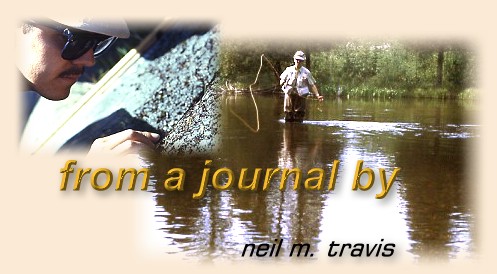Streamside Companions - Swallows

By Neil M. Travis, Montana
The angling experience is composed of many facets, not
the least of which is an appreciation of the myriad
lifeforms with which we share our lakes and streams.
An angler who fails to appreciate the birds, flowers,
insects, and animals he encounters during a day afield
has missed much of what makes any outdoor experience a
memorable event. Anglers who appreciate and observe
these things will enhance their overall enjoyment of
the sport and may also increase their angling success.
Wherever you fish in the continental United States or
Canada one constant avian companion will usually be
present, the swallow. During the summer months eight
species of swallows call some part of this vast area
home.
Swallows are insect eaters, and what better place to
find insects than over a stream, lake, or pond. This
is especially true early in the season when midges,
early season caddis, and mayfly hatches may be the
only source of concentrated insect protein. Tree
Swallows, a cavity nesting species found across the
country, arrive in the northern U.S. the first week
of April. The first swallows are always encountered
over or near water, taking advantage of the readily
available insects.
All species of swallows are graceful birds which wheel
and dive over the water and surrounding land areas
looking for insects. Aerodynamically designed by the
Creator, they are well adapted for catching insects
while on the wing. Swallows have long pointed wings,
short legs, and small bills, but their mouths are wide
for capturing their winged prey.
Observing swallows dipping and darting over the water
is a very enjoyable pastime which helps one forget the
problems of the world, but it also has an angling benefit.
Swallows can tip off the angler to spinner activity and
hatches of small insects which the less observant angler
might miss. Flying high above the water, especially early
in the morning or in the evening, swallows may be feeding
on mayfly imagoes/spinners which are beginning their
mating flight. Many spinner flights start far above the
water, and gradually drop down towards the water surface
as the females enter the swarming males. The angler who
is aware of the meaning of this activity will be
anticipating the resulting spinner fall, and the feeding
activity that it may create.
Swallows have keen eyesight, and their sudden appearance
over the water may signal the beginning of a hatch of
insects. The marked absence of these birds in areas where
they are normally abundant may be an indicator that no
flying insects are available, and the angler may have to
resort to fishing nymphs or other patterns to attract the
fish. The angler who understands this behavior may quickly
take advantage of the situation before other, less
insightful anglers, get the picture.
Some fly fishermen have expressed concern about the
number of swallows they see over their favorite water,
fearing that they may be impacting the hatches. Aquatic
insects, like all insect species, have a multitude of
predators which prey upon them. Even the fish that we
highly prize are predators on the hatches. If that were
not so we could never catch them with artificial flies.
If predators were able to wipe out the prey species,
then they too would become extinct.
One of the methods that insects use to avoid becoming
overwhelmed by the predators are numbers. The number
of aquatic insects in a stream, like a spring creek,
is beyond imagination. If you have ever experienced a
"blanket" hatch of caddis or mayflies, you have some
small idea of the tremendous number of insects that
are present. These insects, hatching in untold numbers,
overwhelm the predators that prey upon them, and insure
the survival of the species. Swallows, like most
predators, tend to feed on the most abundant and
easily captured prey. Thus the minor hatches are
usually not targeted as heavily as are the more
abundant species. The balance between predator and
prey has been going on for thousands of years, and
it is only when man interferes that the balance is upset.
In the fall swallows gather in huge flocks near lakes
and streams before they begin long migration. Telephone
wires sag with their numbers as they prepare for their
exodus. Suddenly, one day, as quickly as they came,
they are gone. This departure is a sign that although
warm days may continue for a time, the long, cold days
of winter will be soon upon us.
Swallows are special streamside companions, a fringe
benefit, given without charge to enhance our enjoyment
of the out-of-doors. When you next encounter these
birds while afield, I hope that you will view them
with greater knowledge and respect for the part they
play in the overall balance of the natural scene.
~ Neil M. Travis, Montana/Arizona
From A Journal Archives
|

